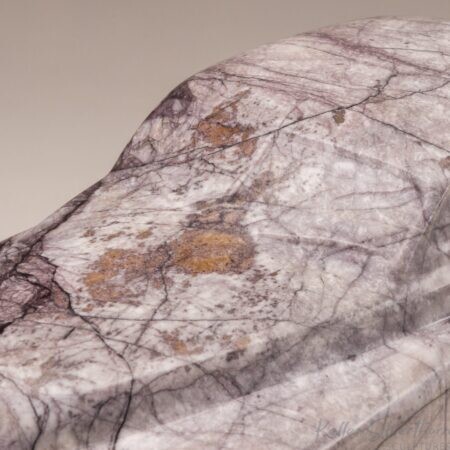LED SLEAD – inspired by the 1949 Mercury custom
hover and click over individual sculpture photographs to enlarge
THE CAR
Lincoln, Mercury, and Ford each had strikingly modern body styling debuts for 1949, under the supervision of design chief Harold Youngren. Each set new sales records. Hollywood, hot rodders, and customizers all fell hard for the ’49 Merc….. James Dean in Rebel Without A Cause, and later American Graffiti, Grease, Cars.
George Barris created one of the first lead sleds in 1949. In 1953 brothers George and Sam Barris created the most famous sled of all time, the Hirohata Merc — possibly the most important custom car to date.
In order to be regarded as a “lead sled” by the custom car tribe, the vehicle was subjected to most, if not all, of the following body style modifications:
Chopped : essentially removing several inches of A, B, and C pillars, and re-welding the now “lowered” roof back on.
Channeled : cutting the underside of the body to lower the entire body on the frame
Sectioned: cutting a horizontal piece cut out of the body, to reduce the belt-line height
Frenched : recessing headlights, tail lights, license plates, and radio antennae into the body for an clean, exotic look.
Shaved: The entire process of removing badges, trim, and door-handles, and to some this would include Drip rail removal, as they detracted from the smooth lines.
Skirted: A removable body panel that is flush with the fender, and covers the upper wheel and tire. More typically present at the rear wheels.
Grilled: the original grill was heavily modified, or substituted with the grill from a completely different make, model, and year car.
In the late 1940s and 1950s, plastic body filler and fiberglas did not exist. Instead, molten bar lead was used as a body filler. A true craftsman pulled and pushed out dents with body spoons, hammers and dollies until the sheet metal was as straight as possible. For any sheet metal that was still slightly wavy, the auto-body-man had to heat bars of lead and flow the molten lead onto the body with an oxygen-acetylene torch. Then file and sand to straight and/or smooth contours.
The term “Sled” referred to the lowering owners undertook of their custom cars so that the body appeared to sit on the ground, like a sled in winter.
As time progressed, plastic putty such as “Bondo” were introduced to the market as a replacement for the toxic lead. Safer and easier. Working the lead is now a lost art.
Ford and Mercury got a new (and final) series of 8B1 flathead V8s for 1949. True, Cadillac and Oldsmobile got impressive OHV V8s in 1949, but for the budgets of the then-enthusiast community those OHV V8s were unobtanium. Flathead Ford engines still owned the hop-up scene of the day. Parts and services for the flattie Ford were numerous. The ‘49s Ford and Mercury were certainly stylish, but the hot rodders and drag racers were not easily pried out of their lightweight favorites, the 1932-34’s Fords.
THE STONE
Milas Lilac has a natural fine web-like veining pattern of dark maroon over a base tone of mottled light maroon and near-white. A more subtle, courser, gold-bronze veining in also present, though less spatially dense. Areas of more confluent gold- bronze are also present. The maroon / white / gold / bronze visual pattern evokes the impression of a custom paint job — particularly when the car shape is that of an iconic custom, such as a ’49 Merc.
The rear wheels are not usually well seen in a Lead Sled, being largely obscured by fender skirts. I decided to play the “sled” card in ways not open to the Barris brothers, and instead of wheels and tires Led Slead has sled-like runners. The gold-bronze of the runners picks up the faint gold-bronze veining and areas of confluent gold-bronze of the stone. A nice visual pop.
While the sculpture looks great in any light, I’m particularly pleased with it in low light. The profile is so iconic, and the low light accentuates the mid-height character-line that flows from rear-to-front, that was so popular in that period of design.












